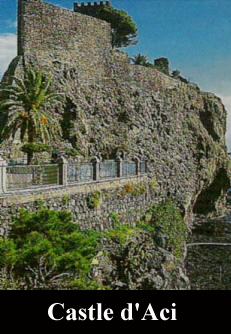Encouraged by the victory at Ponza, Prince Robert renewed his assault on
Messina and drove the city to
the brink of starvation before forced to withdraw to Catania. The Angevins
managed to seize several castles on the island, but the universal
opposition of the population made operating anywhere in the Sicilian
countryside difficult and dangerous. Robert and his father soon realized
that it was going to be extremely difficult to take the island. It also
was clear the Aragonese were going to provide only the support required by
the treaty, as indicated by the fact that there were Catalans and
almugavers
fighting for the Sicilians. Moreover, Charles II was more
interested in the prospect of obtaining the Kingdom of Hungary through the
son of Charles Martel. By 1302, all of the individuals who had been
involved in the start of the war were dead except
Roger of Lauria, and
 Sicily had
become an issue of secondary importance to virtually all of the parties
outside of the island.
Sicily had
become an issue of secondary importance to virtually all of the parties
outside of the island.
In the spring of 1302, the Angevins tried to expand their foothold by seizing Termini while Roger of Lauria attacked Palermo. The attacks met with the same mixed results and by the end of the summer the Angevin forces had once again been stalemated. Charles of Valois who was commanding the Angevin forces had been given instructions that if the situation arose that he could undertake negotiations with Frederick. The fact that Charles II had given him these instructions suggests that much of what happened in the summer of 1302 was simply an attempt by the Angevins to obtain the best possible position before initiating discussions with Frederick III.
After a short period of negotiations, Prince Robert, Charles of Valois, and Frederick III agreed to a peace treaty at Caltabellota on August 31, 1302. Boniface VIII had been virtually excluded from the negotiations and felt frustrated at not recovering Sicily for the Holy See. He finally ratified the treaty on June 12, 1303. For the first time, a settlement was reached which addressed the needs of all of the parties, more or less. Charles II agreed to the removal of all Angevin forces from the island and to cease hostilities. The church lifted all ecclesiastical sanctions from the island. In compensation for Charles's loss of the island, Frederick III agreed to the title of King of Trinacria so that he could not lay claim to the mainland portions of the Kingdom of Sicily. He also agreed to marry Eleanora, the daughter of Charles II, with the understanding that on the death of Frederick the kingdom would revert to Angevin control. Any offspring would be compensated with the island of Sardinia, Cyprus or a payment of one hundred thousand ounces of gold. Both sides agreed to release all prisoners and vowed that any vassals who had rebelled against their lords would loose their fiefs. The only exceptions to the last proviso were two individuals, one of them being Roger of Lauria who was allowed to keep the Castle d'Aci just north of Catania after doing homage to Frederick III for it.


